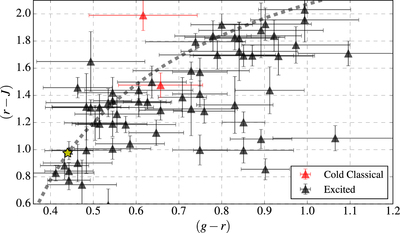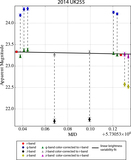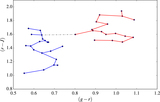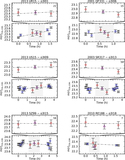Image Details

Caption: Figure 1.
Nonsimultaneous mean observed (converted) grJ color-space measurements of trans-Neptunian populations existing at the conception of the Col-OSSOS survey. Plotted are derived colors for sources with optical and J-band photometry, as indexed by MBOSS (Hainaut et al. 2012) or reported by Peixinho et al. (2015). (g − r) was estimated from the reported (B − V) and the conversion of Jester et al. (2005). (r − J) was estimated by first estimating (r − i) from the reported (R − I) using the conversion reported by Jester et al. (2005) and then estimating (R − r) using the conversion reported by Jordi et al. (2006). (R − r) is used to estimate (r − J) as (r − J) = (R − J)–(R − r). The solar color, with g − r = 0.45 and r − J = 0.97, is shown by the yellow star. The dashed curve indicates the reddening line, a line of constant spectral slope through the grJ spectral range, calculated using the pysynphot software package (Lim et al. 2015). A broad trend of redness relative to the Sun exists, but detail within the population cannot be discerned.
Copyright and Terms & Conditions
© 2019. The American Astronomical Society. All rights reserved.












